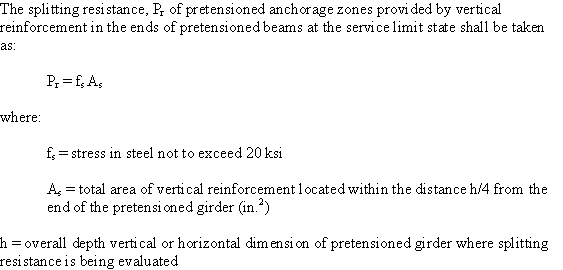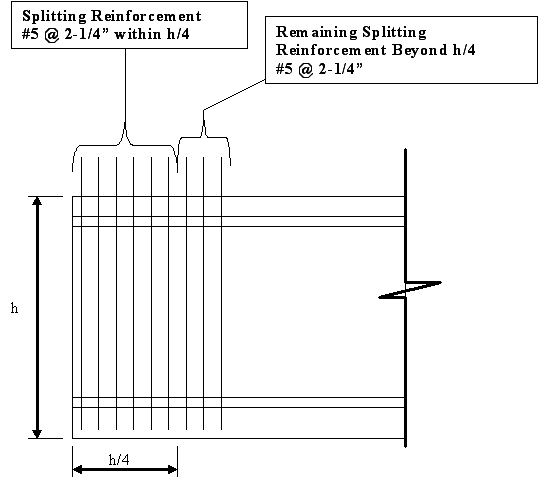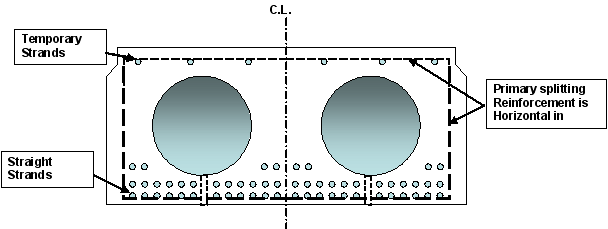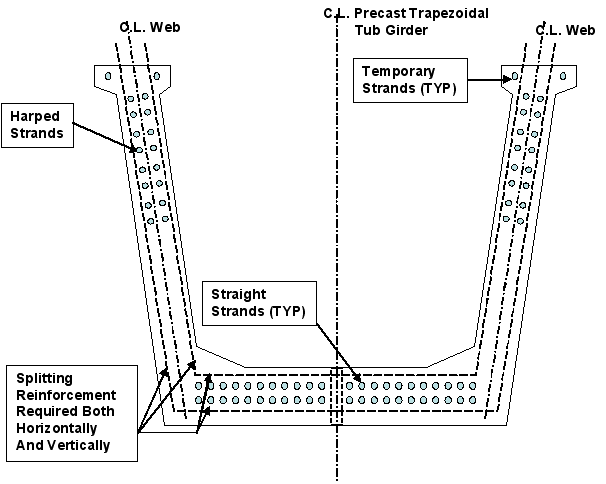
Design Memorandum
TO: All Design Section Staff
FROM: Bijan Khaleghi
DATE: December 23, 2006
SUBJECT: Splitting Resistance of Pretensioned Anchorage Zones

The resistance shall not be less than 4 percent of the total prestressing force at prior to transfer.

the member, where h is the lesser of the overall width or height of the member as shown in Figure 3.
For pretensioned double tees and tri beams, As shall be taken as the total area of vertical reinforcement,
divided evenly among the webs, and located within a distance h/4 from the end of each web.
Background
The provisions of LRFD Article 5.10.10.1 are to resist “splitting” of pretensioned members rather than “bursting”.
LRFD article 5.10.10.1 requires the vertical splitting reinforcement uniformly distributed within the distance
h/4 from end of the girder, where “h” is the overall depth of precast member. To satisfy this requirement some
designers tend to use #6 bars or bundled bars for vertical splitting reinforcement, that is not practical for girder
fabrication and bridge deck construction. For ease of fabrication and deck construction, it is acceptable to place
the remaining splitting reinforcement beyond the code prescribed h/4 zone. Please note that the h/4 zone is an
approximation of the extent of the splitting zone apprehended from the stress contours of finite element analysis or
other refined methods. It is therefore safe and reasonable to extend the splitting zone beyond the code prescribed
h/4 zone if required for girder fabrication and bridge deck construction.
The current reinforcement requirement is defined for pretensioned members with vertical webs. However, splitting
reinforcement is clearly required in other pretensioned members such as slabs, double tees, tri-beams, tubs and
box girders, where the primary splitting reinforcement may not be vertical.
For pretensioned slab members, the width of the member is greater than the depth. A tensile zone is then formed
in the horizontal direction perpendicular to the centerline member.
For tub and box girders, prestressing strands are located in both the bottom flange and webs. Tensile zones are
then formed in both the vertical and horizontal directions in the webs and flanges. Reinforcement is required in
both directions to resist the splitting forces.
If you have any questions regarding this design issue, please contact Bijan Khaleghi at 705-7181.
cc: Mohammad Sheikhizadeh, Bridge Construction - 47354
F. Posner, Bridge and Structures – 47340

Figure 1: Prestressed Girder (Section Near End)

Figure 2: Splitting Reinforcement for Pretensioned Slab Members

Figure 3: Splitting Reinforcement for Pretensioned Tub Members
|





